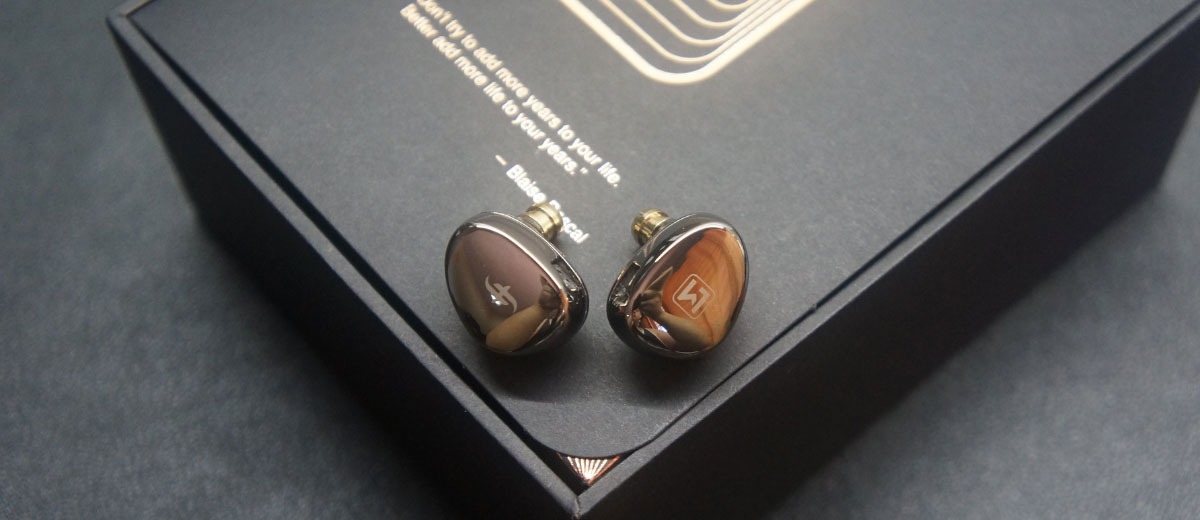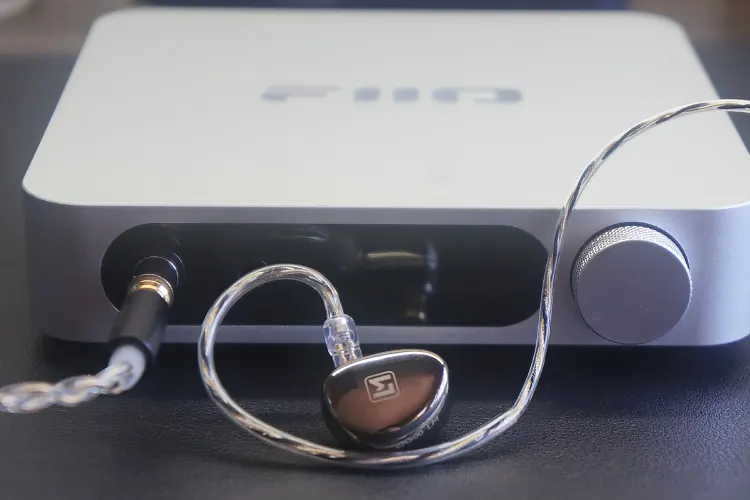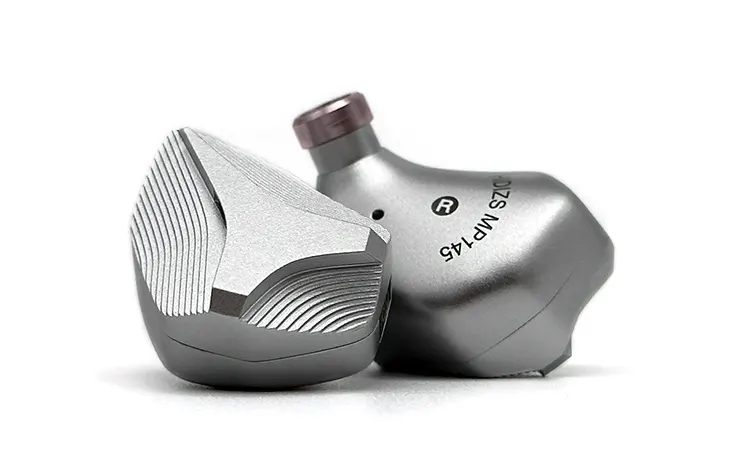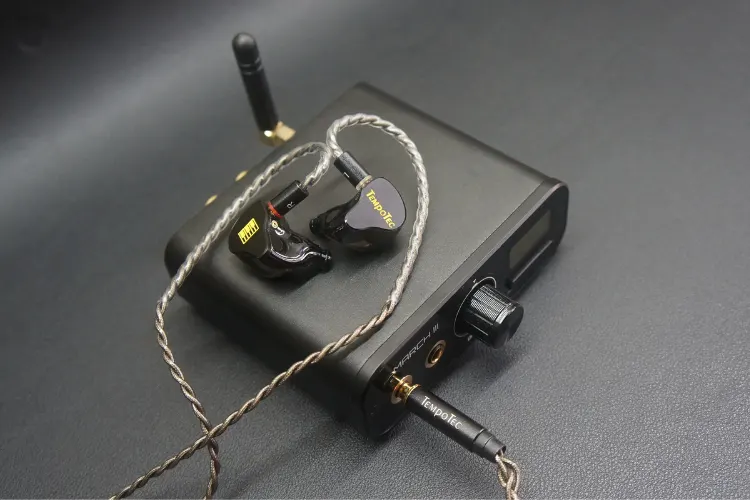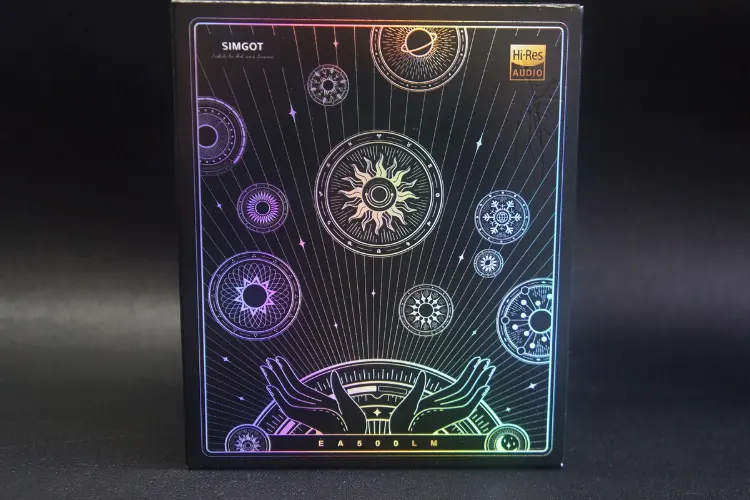Synergy
Efficiency
The EA500LM has an impedance of 21Ω and a sensitivity of 107 dB/mW, making it quite easy to drive.
The IEMs can be powered by most sources, such as laptops and tablets, however, it does benefit from being powered by a more capable DAC/AMP or dongle.
Throughout my on-the-go testing of the EA500LM and its stock 3.5mm cable, I paired it with the 7hz SEVENHERTZ 71 and ddHifi TC35pro E2 dongle DAC. I found that I was getting full extension without any overt artifacts being detected when paired with both dongle DACs.
For desktop use, I paired the EA500LM with the Fiio K11 through its SE output. The Fiio K11 was able to adequately drive the EA500LM to listening levels at around 50% volume on the medium gain setting.
Through the desktop amplifier, I found that the sub-bass hits had a slightly stronger impact, however, the overall resolution and texture performance were identical to that of the dongle DACs.
In my testing, my daily driver ddHiFi TC35Pro Eye2 lightning dongle sufficiently drove the EA500LM while maintaining most of the bass texture of running the EA500LM with the Fiio K11.
Pairings
The EA500LM can pair well with a variety of sources, however, since the 7Hz SEVENHERTZ 71 is a warmer-sounding dongle, I preferred pairing the EA500LM with the more neutral-sounding ddHifi TC35Pro E2 to maintain the tonality that I already found quite pleasing.
Whenever I was using my iPad or my desktop computer wherein a more powerful amplifier was available, I powered the EA500LM with my Fiio K11.
I did not find the need to pair it with a more powerful amplifier since the SE performance of the K11 was already sufficient to maximize the EA500LM’s dynamic range.
Not much performance is lost by moving from the K11 to the Tc35pro E2, but given the option, I would drive it through the desktop K11 only if no convenience is lost.
Select Comparisons
Hidizs MP145
Technical
The Hidizs MP145 uses a single 14.5mm planar magnetic driver, while the EA500LM opts for a second-generation lithium magnesium dynamic driver.
The MP145 has an impedance and sensitivity of 30Ω and 104 dB/mW @1kHz, while the EA500LM has an impedance and sensitivity of 21Ω and 107 dB/mW.
Design
The Hidizs MP145 is built from CNC-machined aluminum materials with an ergonomic whale-inspired shell. The geometric shapes of the MP145 make it visually stand out, especially with the metallic finish of the shell material used.
In contrast, the EA500LM uses a full metal shell, however, it does not have the same decorative geometric patterns as the MP145. The EA500LM also trades in the subdued flat metal finish of the MP145 for a mirror finish which is prone to significantly more fingerprints.
In day-to-day usage, I found that the EA500LM slightly edges out the MP145 in terms of comfort since the EA500LM’s nozzle is pushed further away from the widest point of the body, preventing it from rubbing against my ear.
Performance
The MP145 has a more prominent V-shaped sound signature, while the EA500LM has a more U-shaped sound signature with a slight emphasis on the sub-bass region.
The EA500LM has a stronger and deeper bass performance, with its dynamic driver providing more bass quantity with more texture and depth.
Bass drums have a chesty impact when played through the EA500LM. In comparison, the reproduction of the same notes through the MP145 comes off as one-dimensional.
Another stand out is how much more proficient the EA500LM is playing back prolonged hums and rumble notes with subtle yet textured tonality, something the MP145 does not even come close to matching.
The mid-range of the MP145 is significantly more resolving than that of the EA500LM. This increase in resolution does not come at the expense of musicality.
The MP145 maintains a pleasing tonality that gives vocals a natural yet detailed signature. It also provides string and brass instruments with more depth and musicality than that of the EA500LM.
Across the board, I found that the mid-range performance of the MP145 was more pleasing and technically impressive than the EA500LM.
The MP145 was not only more resolving and energetic than the EA500LM but also had less sharpness and sibilance in the upper treble region. The MP145 played back trebly with more air and energy, with every cymbal strike played with a crispy tonality.
The MP145 also had better control of the treble region, not letting notes peak too high and reach the point of fatigue, which is something the EA500LM struggles with in some tracks.
Tempotec IM05
Technical
The SIMGOT EA500LM uses a single lithium magnesium dynamic driver, while the TempoTec IM05 takes a hybrid approach, incorporating a single 8mm dynamic driver and four balanced armature drivers.
The TempoTec IM05 has an impedance of 16Ω and a sensitivity of 106 dB/mW, while the EA500LM has an impedance of 21Ω and a sensitivity of 107 db/mW. In practice, I found that the EA500LM was slightly easier to drive.
Design
The IM05 uses a shell that seems to be constructed from 3D-printed semi-translucent resin with a glossy finish. It has a separate metal face plate with a brushed black metal finish with a stylized yellow piano or TempoTec logo depending on the earpiece side.
In comparison, the EA500LM has a more premium feeling all metal construction throughout the entire shell, with both faceplate and body having the same mirror-like finish throughout, making it much more of a fingerprint magnet.
This makes the IM05 significantly lighter than the EA500LM, especially when comparing the in-ear comfort of both IEMs.
I found that the lighter weight and contoured shell of the IM05 made it more comfortable than the EA500LM, but the EA500LM is by no means uncomfortable.
Performance
The IM05 has a steep V-shaped sound signature, whilst the EA500LM has a gentle U-shaped sound signature with a slight emphasis on the sub-bass region.
Both IEMs have a similar amount of sub-bass, but I found that the EA500LM can play them back with better texture. Long hums, in particular, highlight this difference, with the EA500LM able to resolve more nuanced detail making the IM05 sound one-dimensional.
The IM05 has more mid-bass than the EA500LM. However, I also found that this mid-bass tended to bleed into the mid-range, muddying up the whole sound signature of the IEM. With this amount of sub-bass bloat, I found the more balanced EA500LM to have a more pleasing bass performance.
The EA500LM outclasses the IM05 when it comes to mid-range performance. When swapping from the EA500LM to the IM05, what immediately stood out was how flat the vocals sounded on the IM05.
It’s as if all vocal nuance and air was sucked out of the mix the moment I swapped to the IM05. The string instrument and brass resolution also took a hit, coming off as veiled and muffled.
The highs of the EA500LM are significantly more resolving and sparkly compared to the IM05. Cymbal strikes, chimes, and even upper register vocals are played back with a good sense of air and energy from the EA500LM.
In comparison, the IM05 once again comes off as flat. Different cymbals in complex mixes are easily distinguishable through the EA500LM, but through the IM05, all these tones come off with little to differentiate them.
Shanling Sono
Technical
The SIMGOT EA500LM’s single lithium magnesium dynamic driver is pitched against the Shanling SONO’s hybrid dual dynamic drivers in a coaxial configuration with a custom-made BA for the upper frequencies.
The SIMGOT EA500LM has an impedance of 16Ω and a sensitivity of 106 dB/mW, while the Sono has an impedance of 16Ω and a sensitivity of 103 dB/mW. In practice, I found the EA500LM slightly easier to drive, but not by much.
Design
Both EA500LM and Shanling Sono use an all-metal build with a mirror-like finish. The metal used on the EA500LM has a darker shade, giving it a more subdued aesthetic, however, both IEMs still have a mirror-like reflectivity.
Surprisingly, I found the SIMGOT was much more of a fingerprint magnet than the Shanling. In practice, I also found that the EA500LM was more comfortable, despite the Sono being the smaller of the two. However, neither IEM is by any means uncomfortable.
Performance
The sound profile between both IEMs is somewhat similar, with the EA500LM having a gentle U-shaped sound signature with a bump in the sub-bass region, and the Sono having a shallow V-shaped sound signature.
The mid-bass of the Sono has a little more emphasis than that of the EA500LM, with both IEMs having a similar amount of sub-bass.
Once again, the texture and sheer fidelity of the EA500LM’s sub-bass stands out, also being able to deliver bass that is “felt instead of heard” to a better degree than the Sono.
The mid-range performance between both IEMs is quite similar in terms of tonality, with a similar level of fidelity and resolution between both the EA500LM and the Sono, particularly in the string and vocal region.
However, the more bloated mid-bass of the Sono contributes to its mid-range coming off as more veiled, with the EA500LM doing a better job at delivering a clean yet detailed midrange tonality.
The treble performance of the EA500LM is better than that of the Sono across the board. Cymbals, chimes, and other tones in the treble region are played back with more sparkle and resolution, contributing to a more exciting sound signature.
In comparison, the Sono plays back the same notes with less energy but also plays them back with unfortunately more sibilance as well.
My Verdict
The SIMGOT EA500LM is a well-built pair of IEMs that incorporate an exciting sub-bass, enjoyable overall sound signature, and decent technicalities at a sub-$100 price point.
Its build quality is excellent for its price, using premium-feeling materials and design choices, without sacrificing comfort or everyday usability except for its fingerprint susceptible finish.
Based on our testing, it more than keeps current IEMs almost twice its price in build quality and performance.
With an enjoyable tonality that boosts excitement in most music genres, the EA500LM is a must-try for audio enthusiasts wanting an upgrade from their sub-$100 IEMs, or even as a starting point for people just trying to get into the hobby for under a Benjamin.
SIMGOT EA500LM Technical Specifications
- Driver Type: Lithium Magnesium 10mm dynamic driver
- Plug: 3.5mm SE
- Frequency Response: 20Hz-40kHz
- Impedance: 16Ω
- Sensitivity: 106 dB

